-
 Midterm Presentation
Midterm Presentation
-
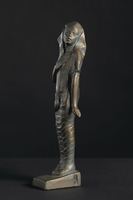 Ethiopia
Ethiopia Painted plaster sculpture of a female figure standing with her right hand over her heart, her left arm straight against her side with her hand extended out. Her head is turned over her left shoulder. From the hips down her legs are bound as if mummified. She wears a veil that is draped over her head and falls over her shoulders and down her back. The veil is shaped to resemble a pharaonic headdress. The figure stands on a rectangular, slightly wedge shaped pedestal. The sculpture is painted to look like copper complete with a simulated greenish patina. (Smithsonian Collections Search Center)
-
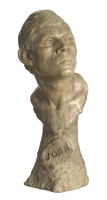 John the Baptist
John the Baptist A painted plaster sculpture bust of John the Baptist. The head is turned slightly to the left, with closely cropped hair. The face is alert, with raised chin and open eyes. There is a tall integrated mount and base extending from the bust. It features an oval roundel inscribed with the name "John." The sculpture is painted a light beige. (Smithsonian Collections Search Center)
-
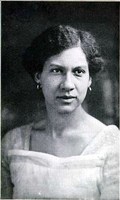 Metta Vaux Warrick Fuller
Metta Vaux Warrick Fuller Meta Warrick Fuller was a black female artist who specialized in sculpture. Born in Philadelphia, Pennsylvania in 1877, her career peaked during America’s Gilded Age, a time when more women were trained as artists than ever before. She attended the Pennsylvania Museum School of Industrial Arts in 1897 (now Pennsylvania College of Art) before traveling abroad to study in Paris, France in 1899. Warrick studied at the Académie Colarossi for sculpture and La Ecole des Beaux Arts for drawing. It was during this time that she met Auguste Rodin, who encouraged her to continue the sculptural realism that she loved. This advice invigorated her art. With her new confidence, she exhibited at Samuel Bing’s L’Art Nouveau Gallery in Paris in 1900. (Black Past)
-
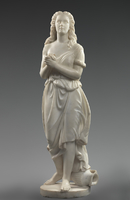 Hagar
Hagar
-
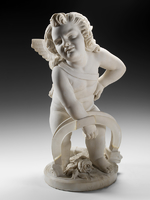 Poor Cupid
Poor Cupid Edmonia Lewis occasionally carved sculptures of mythical scenes, which were very popular with American tourists visiting Rome. Poor Cupid, or Love Ensnared, depicts the cherub with his hand caught in a trap as he reaches down for a rose. Frivolous sculptures like this appealed to the Victorian sentimentality of affluent Americans traveling around Europe.
(Smithsonian Collections Search Center)
-
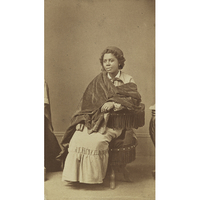 Edmonia Lewis
Edmonia Lewis Edmonia Lewis achieved international recognition as a sculptor during the second half of the nineteenth century. Educated at Oberlin College, she settled first in Boston, where she created portrait busts and medallions of prominent politicians, writers, and abolitionists. In 1865 she relocated to Rome and joined an active community of American and British artists living abroad. Adopting a neoclassical style then widely popular, she found inspiration in stories from the Bible and classical mythology, as well as from African American history. Her sculpture Forever Free (1867) depicts an African American couple as they first hear news of the Emancipation Proclamation. The work led one critic to exclaim, "No one, not born subject to the 'Cotton King,' could look upon this piece of sculpture without profound emotion." Although Lewis enjoyed unprecedented success for several decades, she died in obscurity. (Smithsonian Collections Search Center)
-
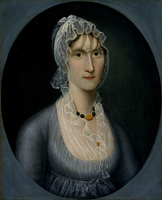 Portrait of Mrs. Barbara Baker Murphy (Wife of Sea Captain)
Portrait of Mrs. Barbara Baker Murphy (Wife of Sea Captain) Joshua Johnson, a self-trained artist and former slave, is the earliest documented professional African American painter. His sitters were Captain John Murphy and his wife, Irish immigrants who lived in Baltimore, where Johnson painted many merchants, seamen, and their families. In these portraits--intended to hang side-by-side--the artist delighted in fine details, from the captain's artfully arranged curls to his wife's sheer lace collar.
-
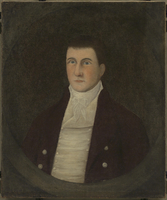 Portrait of John Westwood
Portrait of John Westwood An oil painting portrait of John Westwood, painted in conventional English portrait style of formal, bust-length pose and arranged backdrop. It depicts a half-length male figure wearing a brown coat with silver buttons and white waistcoat against a dark background. The figure is clean shaven with short brown hair, and is encircled by a faux oval frame. Painted as part of the composition, the oval frame is slightly lighter in color than the background. (Smithsonian Collections Search Center)
-
 Portrait of Adelia Ellender
Portrait of Adelia Ellender Adelia Ellender lived in Baltimore, Maryland, where her father was a plasterer. Her dress follows the custom in this period of portraying children as miniature adults. The berries in her hand and the butterfly hovering in a rosebush nearby symbolize not only her childhood innocence but her eventual transformation into a lady
-
 Joshua Johnson
Joshua Johnson Joshua Johnson, or Johnston, the earliest documented professional African-American painter, was active in Baltimore during the late eighteenth and first quarter of the nineteenth century. His background, however, remains a mystery. The families and descendants of those whose portraits he painted claim that Johnson was a former slave. Whether Johnson was a slave or not is open to question since his name appears in the City Directory of Baltimore from 1796 to 1824, when the directory did not list slaves. Johnson's identity as an African American has been questioned as well. In editions of the directory in which an asterisk designated a person of color, there is no asterisk by Johnson's name. Johnson may have been biracial and fair enough to elude identification as an African American by publishers of the directory. In the directory of 1817, however, Johnson's name appears among the "free householders of Color" listed separately in the publication. (Smithsonian American Art Museum)
-
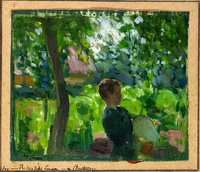 The Bagpipe Lesson
The Bagpipe Lesson This study shows a boy practicing the bagpipe, but for the final version, Henry Ossawa Tanner added a teacher and two more figures. Bagpipe players were common in the French region of Pont-Aven and Concarneau, where Tanner spent his summers in the 1890s. Here, he used bold colors and loose brushwork to capture the scene. Tanner entered a finished version in the annual Paris exhibition, but it was rejected; the Pennsylvania Academy of the Fine Arts, however, accepted it for their yearly show. (Smithsonian Collections Search Center)
-
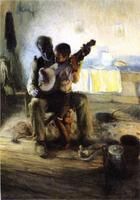 The Banjo Lesson
The Banjo Lesson
-
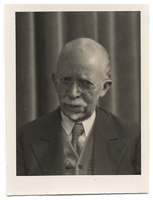 Henry Ossawa Tanner
Henry Ossawa Tanner The most distinguished African-American artist of the nineteenth century, Henry Ossawa Tanner was also the first artist of his race to achieve international acclaim. Tanner was born on June 21, 1859, in Pittsburgh, Pennsylvania, to Benjamin Tucker and Sarah Miller Tanner. Tanner's father was a college-educated teacher and minister who later became a bishop in the African Methodist Episcopalian Church. Sarah Tanner was a former slave whose mother had sent her north to Pittsburgh through the Underground Railroad. Tanner's family moved frequently during his early years when his father was assigned to various churches and schools. In 1864 Tanner's family settled in Philadelphia where his early artistic interests were developed. At age thirteen, Tanner decided to become an artist when he saw a painter at work during a walk in Fairmount Park near his home. Throughout his teens, Tanner painted and drew constantly in his spare time and tried to look at art as much as possible in Philadelphia art galleries. He also studied briefly with two of the city's minor painters. (Smithsonian Museum of American Art)
-
 Romantic Landscape
Romantic Landscape
-
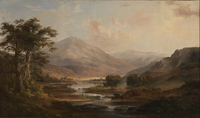 Scottish Landscape
Scottish Landscape Robert S. Duncanson made several trips to Scotland, probably inspired by his father's Scottish heritage. He created romantic wilderness views that may have been influenced by the novels and poems of Sir Walter Scott. In this piece the warm colors and rich vegetation make a remote scene appear welcoming, and would have appealed to the sentimental tastes of his American patrons.
-
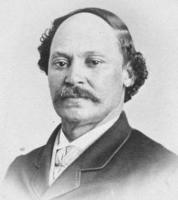 Robert Duncanson
Robert Duncanson Robert Scott Duncanson was perhaps the most accomplished African-American painter in the United States from 1850 to 1860. He was born in Seneca County, New York, in 1821 to an African-American mother and Scottish-Canadian father, who sent his son to Canadian schools during his youth. In 1841 Duncanson and his mother moved to Mt. Healthy, Ohio, near Cincinnati. Little else is known about Duncanson's early life except that his second wife Phoebe was biracial, and the couple's only child, a son Mittie, was born in Cincinnati.
-
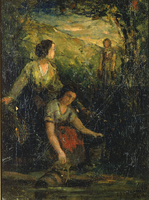 The Drinking Pool (three women at the water)
The Drinking Pool (three women at the water)
-
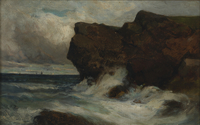 Ocean Cliffs
Ocean Cliffs
-
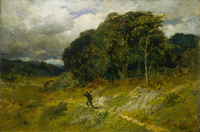 Approaching Storm
Approaching Storm This windy scene of a lone figure struggling in the face of a storm would have held special meaning for nineteenth-century viewers, who believed that their nation's landscape was infused with God's presence. In 1886, the year he painted Approaching Storm, Edward Mitchell Bannister wrote an essay titled "The Artist and His Critics," in which he argued that spiritual expression is the artist's ultimate goal. (Hartigan, Sharing Traditions, 1985)
-
 Boat on Sea
Boat on Sea The sea was a favorite subject for Edward Mitchell Bannister, who had worked as a cook on a trading ship. In this peaceful view of Rhode Island’s Narragansett Bay, a popular subject for nineteenth-century American artists, he focused attention on the brilliant coastal light. Bannister was a deeply religious man who shared with many Americans of his time a belief that nature was an expression of God’s presence. In this scene the radiant light illuminates the bay to suggest a divine blessing. (Narratives of African American Art and Identity: The David C. Driskell Collection, 1998)
-
 Edward Mitchell Bannister
Edward Mitchell Bannister Edward Mitchell Bannister became one of the first African American painters to gain national recognition when his landscape Under the Oaks won a first prize at the Centennial Exposition in Philadelphia (1876). Almost entirely self-taught, Bannister began his career in the 1850s in Boston, where he enjoyed the patronage of that city's substantial black community. He was also a committed abolitionist who continued to advocate for African American rights after the Civil War. When Bannister settled in Providence, Rhode Island, in 1869, his reputation grew as his landscapes and coastal views were exhibited more widely. His name proved unfamiliar, however, to the Centennial Exposition judges, who tried to withhold his prize upon discovering that he was African American. When the other artists threatened to withdraw from the competition if Bannister was denied his medal, the original award was upheld.
-
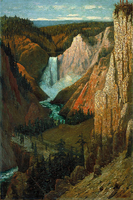 View of the Lowe Falls, Grand Canyon of the Yellowstone
View of the Lowe Falls, Grand Canyon of the Yellowstone
-
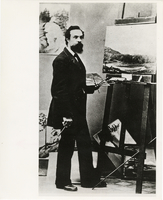 Portrait of Grafton Tyler Brown
Portrait of Grafton Tyler Brown Portrait of Grafton Tyler Brown, San Francisco artist and lithographer, from "Blacks in the Westward Movement" exhibition at Anacostia Neighborhood Museum.
 Midterm Presentation
Midterm Presentation
 Ethiopia Painted plaster sculpture of a female figure standing with her right hand over her heart, her left arm straight against her side with her hand extended out. Her head is turned over her left shoulder. From the hips down her legs are bound as if mummified. She wears a veil that is draped over her head and falls over her shoulders and down her back. The veil is shaped to resemble a pharaonic headdress. The figure stands on a rectangular, slightly wedge shaped pedestal. The sculpture is painted to look like copper complete with a simulated greenish patina. (Smithsonian Collections Search Center)
Ethiopia Painted plaster sculpture of a female figure standing with her right hand over her heart, her left arm straight against her side with her hand extended out. Her head is turned over her left shoulder. From the hips down her legs are bound as if mummified. She wears a veil that is draped over her head and falls over her shoulders and down her back. The veil is shaped to resemble a pharaonic headdress. The figure stands on a rectangular, slightly wedge shaped pedestal. The sculpture is painted to look like copper complete with a simulated greenish patina. (Smithsonian Collections Search Center) John the Baptist A painted plaster sculpture bust of John the Baptist. The head is turned slightly to the left, with closely cropped hair. The face is alert, with raised chin and open eyes. There is a tall integrated mount and base extending from the bust. It features an oval roundel inscribed with the name "John." The sculpture is painted a light beige. (Smithsonian Collections Search Center)
John the Baptist A painted plaster sculpture bust of John the Baptist. The head is turned slightly to the left, with closely cropped hair. The face is alert, with raised chin and open eyes. There is a tall integrated mount and base extending from the bust. It features an oval roundel inscribed with the name "John." The sculpture is painted a light beige. (Smithsonian Collections Search Center) Metta Vaux Warrick Fuller Meta Warrick Fuller was a black female artist who specialized in sculpture. Born in Philadelphia, Pennsylvania in 1877, her career peaked during America’s Gilded Age, a time when more women were trained as artists than ever before. She attended the Pennsylvania Museum School of Industrial Arts in 1897 (now Pennsylvania College of Art) before traveling abroad to study in Paris, France in 1899. Warrick studied at the Académie Colarossi for sculpture and La Ecole des Beaux Arts for drawing. It was during this time that she met Auguste Rodin, who encouraged her to continue the sculptural realism that she loved. This advice invigorated her art. With her new confidence, she exhibited at Samuel Bing’s L’Art Nouveau Gallery in Paris in 1900. (Black Past)
Metta Vaux Warrick Fuller Meta Warrick Fuller was a black female artist who specialized in sculpture. Born in Philadelphia, Pennsylvania in 1877, her career peaked during America’s Gilded Age, a time when more women were trained as artists than ever before. She attended the Pennsylvania Museum School of Industrial Arts in 1897 (now Pennsylvania College of Art) before traveling abroad to study in Paris, France in 1899. Warrick studied at the Académie Colarossi for sculpture and La Ecole des Beaux Arts for drawing. It was during this time that she met Auguste Rodin, who encouraged her to continue the sculptural realism that she loved. This advice invigorated her art. With her new confidence, she exhibited at Samuel Bing’s L’Art Nouveau Gallery in Paris in 1900. (Black Past) Hagar
Hagar
 Poor Cupid Edmonia Lewis occasionally carved sculptures of mythical scenes, which were very popular with American tourists visiting Rome. Poor Cupid, or Love Ensnared, depicts the cherub with his hand caught in a trap as he reaches down for a rose. Frivolous sculptures like this appealed to the Victorian sentimentality of affluent Americans traveling around Europe. (Smithsonian Collections Search Center)
Poor Cupid Edmonia Lewis occasionally carved sculptures of mythical scenes, which were very popular with American tourists visiting Rome. Poor Cupid, or Love Ensnared, depicts the cherub with his hand caught in a trap as he reaches down for a rose. Frivolous sculptures like this appealed to the Victorian sentimentality of affluent Americans traveling around Europe. (Smithsonian Collections Search Center) Edmonia Lewis Edmonia Lewis achieved international recognition as a sculptor during the second half of the nineteenth century. Educated at Oberlin College, she settled first in Boston, where she created portrait busts and medallions of prominent politicians, writers, and abolitionists. In 1865 she relocated to Rome and joined an active community of American and British artists living abroad. Adopting a neoclassical style then widely popular, she found inspiration in stories from the Bible and classical mythology, as well as from African American history. Her sculpture Forever Free (1867) depicts an African American couple as they first hear news of the Emancipation Proclamation. The work led one critic to exclaim, "No one, not born subject to the 'Cotton King,' could look upon this piece of sculpture without profound emotion." Although Lewis enjoyed unprecedented success for several decades, she died in obscurity. (Smithsonian Collections Search Center)
Edmonia Lewis Edmonia Lewis achieved international recognition as a sculptor during the second half of the nineteenth century. Educated at Oberlin College, she settled first in Boston, where she created portrait busts and medallions of prominent politicians, writers, and abolitionists. In 1865 she relocated to Rome and joined an active community of American and British artists living abroad. Adopting a neoclassical style then widely popular, she found inspiration in stories from the Bible and classical mythology, as well as from African American history. Her sculpture Forever Free (1867) depicts an African American couple as they first hear news of the Emancipation Proclamation. The work led one critic to exclaim, "No one, not born subject to the 'Cotton King,' could look upon this piece of sculpture without profound emotion." Although Lewis enjoyed unprecedented success for several decades, she died in obscurity. (Smithsonian Collections Search Center) Portrait of Mrs. Barbara Baker Murphy (Wife of Sea Captain) Joshua Johnson, a self-trained artist and former slave, is the earliest documented professional African American painter. His sitters were Captain John Murphy and his wife, Irish immigrants who lived in Baltimore, where Johnson painted many merchants, seamen, and their families. In these portraits--intended to hang side-by-side--the artist delighted in fine details, from the captain's artfully arranged curls to his wife's sheer lace collar.
Portrait of Mrs. Barbara Baker Murphy (Wife of Sea Captain) Joshua Johnson, a self-trained artist and former slave, is the earliest documented professional African American painter. His sitters were Captain John Murphy and his wife, Irish immigrants who lived in Baltimore, where Johnson painted many merchants, seamen, and their families. In these portraits--intended to hang side-by-side--the artist delighted in fine details, from the captain's artfully arranged curls to his wife's sheer lace collar. Portrait of John Westwood An oil painting portrait of John Westwood, painted in conventional English portrait style of formal, bust-length pose and arranged backdrop. It depicts a half-length male figure wearing a brown coat with silver buttons and white waistcoat against a dark background. The figure is clean shaven with short brown hair, and is encircled by a faux oval frame. Painted as part of the composition, the oval frame is slightly lighter in color than the background. (Smithsonian Collections Search Center)
Portrait of John Westwood An oil painting portrait of John Westwood, painted in conventional English portrait style of formal, bust-length pose and arranged backdrop. It depicts a half-length male figure wearing a brown coat with silver buttons and white waistcoat against a dark background. The figure is clean shaven with short brown hair, and is encircled by a faux oval frame. Painted as part of the composition, the oval frame is slightly lighter in color than the background. (Smithsonian Collections Search Center) Portrait of Adelia Ellender Adelia Ellender lived in Baltimore, Maryland, where her father was a plasterer. Her dress follows the custom in this period of portraying children as miniature adults. The berries in her hand and the butterfly hovering in a rosebush nearby symbolize not only her childhood innocence but her eventual transformation into a lady
Portrait of Adelia Ellender Adelia Ellender lived in Baltimore, Maryland, where her father was a plasterer. Her dress follows the custom in this period of portraying children as miniature adults. The berries in her hand and the butterfly hovering in a rosebush nearby symbolize not only her childhood innocence but her eventual transformation into a lady Joshua Johnson Joshua Johnson, or Johnston, the earliest documented professional African-American painter, was active in Baltimore during the late eighteenth and first quarter of the nineteenth century. His background, however, remains a mystery. The families and descendants of those whose portraits he painted claim that Johnson was a former slave. Whether Johnson was a slave or not is open to question since his name appears in the City Directory of Baltimore from 1796 to 1824, when the directory did not list slaves. Johnson's identity as an African American has been questioned as well. In editions of the directory in which an asterisk designated a person of color, there is no asterisk by Johnson's name. Johnson may have been biracial and fair enough to elude identification as an African American by publishers of the directory. In the directory of 1817, however, Johnson's name appears among the "free householders of Color" listed separately in the publication. (Smithsonian American Art Museum)
Joshua Johnson Joshua Johnson, or Johnston, the earliest documented professional African-American painter, was active in Baltimore during the late eighteenth and first quarter of the nineteenth century. His background, however, remains a mystery. The families and descendants of those whose portraits he painted claim that Johnson was a former slave. Whether Johnson was a slave or not is open to question since his name appears in the City Directory of Baltimore from 1796 to 1824, when the directory did not list slaves. Johnson's identity as an African American has been questioned as well. In editions of the directory in which an asterisk designated a person of color, there is no asterisk by Johnson's name. Johnson may have been biracial and fair enough to elude identification as an African American by publishers of the directory. In the directory of 1817, however, Johnson's name appears among the "free householders of Color" listed separately in the publication. (Smithsonian American Art Museum) The Bagpipe Lesson This study shows a boy practicing the bagpipe, but for the final version, Henry Ossawa Tanner added a teacher and two more figures. Bagpipe players were common in the French region of Pont-Aven and Concarneau, where Tanner spent his summers in the 1890s. Here, he used bold colors and loose brushwork to capture the scene. Tanner entered a finished version in the annual Paris exhibition, but it was rejected; the Pennsylvania Academy of the Fine Arts, however, accepted it for their yearly show. (Smithsonian Collections Search Center)
The Bagpipe Lesson This study shows a boy practicing the bagpipe, but for the final version, Henry Ossawa Tanner added a teacher and two more figures. Bagpipe players were common in the French region of Pont-Aven and Concarneau, where Tanner spent his summers in the 1890s. Here, he used bold colors and loose brushwork to capture the scene. Tanner entered a finished version in the annual Paris exhibition, but it was rejected; the Pennsylvania Academy of the Fine Arts, however, accepted it for their yearly show. (Smithsonian Collections Search Center) The Banjo Lesson
The Banjo Lesson
 Henry Ossawa Tanner The most distinguished African-American artist of the nineteenth century, Henry Ossawa Tanner was also the first artist of his race to achieve international acclaim. Tanner was born on June 21, 1859, in Pittsburgh, Pennsylvania, to Benjamin Tucker and Sarah Miller Tanner. Tanner's father was a college-educated teacher and minister who later became a bishop in the African Methodist Episcopalian Church. Sarah Tanner was a former slave whose mother had sent her north to Pittsburgh through the Underground Railroad. Tanner's family moved frequently during his early years when his father was assigned to various churches and schools. In 1864 Tanner's family settled in Philadelphia where his early artistic interests were developed. At age thirteen, Tanner decided to become an artist when he saw a painter at work during a walk in Fairmount Park near his home. Throughout his teens, Tanner painted and drew constantly in his spare time and tried to look at art as much as possible in Philadelphia art galleries. He also studied briefly with two of the city's minor painters. (Smithsonian Museum of American Art)
Henry Ossawa Tanner The most distinguished African-American artist of the nineteenth century, Henry Ossawa Tanner was also the first artist of his race to achieve international acclaim. Tanner was born on June 21, 1859, in Pittsburgh, Pennsylvania, to Benjamin Tucker and Sarah Miller Tanner. Tanner's father was a college-educated teacher and minister who later became a bishop in the African Methodist Episcopalian Church. Sarah Tanner was a former slave whose mother had sent her north to Pittsburgh through the Underground Railroad. Tanner's family moved frequently during his early years when his father was assigned to various churches and schools. In 1864 Tanner's family settled in Philadelphia where his early artistic interests were developed. At age thirteen, Tanner decided to become an artist when he saw a painter at work during a walk in Fairmount Park near his home. Throughout his teens, Tanner painted and drew constantly in his spare time and tried to look at art as much as possible in Philadelphia art galleries. He also studied briefly with two of the city's minor painters. (Smithsonian Museum of American Art) Romantic Landscape
Romantic Landscape
 Scottish Landscape Robert S. Duncanson made several trips to Scotland, probably inspired by his father's Scottish heritage. He created romantic wilderness views that may have been influenced by the novels and poems of Sir Walter Scott. In this piece the warm colors and rich vegetation make a remote scene appear welcoming, and would have appealed to the sentimental tastes of his American patrons.
Scottish Landscape Robert S. Duncanson made several trips to Scotland, probably inspired by his father's Scottish heritage. He created romantic wilderness views that may have been influenced by the novels and poems of Sir Walter Scott. In this piece the warm colors and rich vegetation make a remote scene appear welcoming, and would have appealed to the sentimental tastes of his American patrons. Robert Duncanson Robert Scott Duncanson was perhaps the most accomplished African-American painter in the United States from 1850 to 1860. He was born in Seneca County, New York, in 1821 to an African-American mother and Scottish-Canadian father, who sent his son to Canadian schools during his youth. In 1841 Duncanson and his mother moved to Mt. Healthy, Ohio, near Cincinnati. Little else is known about Duncanson's early life except that his second wife Phoebe was biracial, and the couple's only child, a son Mittie, was born in Cincinnati.
Robert Duncanson Robert Scott Duncanson was perhaps the most accomplished African-American painter in the United States from 1850 to 1860. He was born in Seneca County, New York, in 1821 to an African-American mother and Scottish-Canadian father, who sent his son to Canadian schools during his youth. In 1841 Duncanson and his mother moved to Mt. Healthy, Ohio, near Cincinnati. Little else is known about Duncanson's early life except that his second wife Phoebe was biracial, and the couple's only child, a son Mittie, was born in Cincinnati. The Drinking Pool (three women at the water)
The Drinking Pool (three women at the water)
 Ocean Cliffs
Ocean Cliffs
 Approaching Storm This windy scene of a lone figure struggling in the face of a storm would have held special meaning for nineteenth-century viewers, who believed that their nation's landscape was infused with God's presence. In 1886, the year he painted Approaching Storm, Edward Mitchell Bannister wrote an essay titled "The Artist and His Critics," in which he argued that spiritual expression is the artist's ultimate goal. (Hartigan, Sharing Traditions, 1985)
Approaching Storm This windy scene of a lone figure struggling in the face of a storm would have held special meaning for nineteenth-century viewers, who believed that their nation's landscape was infused with God's presence. In 1886, the year he painted Approaching Storm, Edward Mitchell Bannister wrote an essay titled "The Artist and His Critics," in which he argued that spiritual expression is the artist's ultimate goal. (Hartigan, Sharing Traditions, 1985) Boat on Sea The sea was a favorite subject for Edward Mitchell Bannister, who had worked as a cook on a trading ship. In this peaceful view of Rhode Island’s Narragansett Bay, a popular subject for nineteenth-century American artists, he focused attention on the brilliant coastal light. Bannister was a deeply religious man who shared with many Americans of his time a belief that nature was an expression of God’s presence. In this scene the radiant light illuminates the bay to suggest a divine blessing. (Narratives of African American Art and Identity: The David C. Driskell Collection, 1998)
Boat on Sea The sea was a favorite subject for Edward Mitchell Bannister, who had worked as a cook on a trading ship. In this peaceful view of Rhode Island’s Narragansett Bay, a popular subject for nineteenth-century American artists, he focused attention on the brilliant coastal light. Bannister was a deeply religious man who shared with many Americans of his time a belief that nature was an expression of God’s presence. In this scene the radiant light illuminates the bay to suggest a divine blessing. (Narratives of African American Art and Identity: The David C. Driskell Collection, 1998) Edward Mitchell Bannister Edward Mitchell Bannister became one of the first African American painters to gain national recognition when his landscape Under the Oaks won a first prize at the Centennial Exposition in Philadelphia (1876). Almost entirely self-taught, Bannister began his career in the 1850s in Boston, where he enjoyed the patronage of that city's substantial black community. He was also a committed abolitionist who continued to advocate for African American rights after the Civil War. When Bannister settled in Providence, Rhode Island, in 1869, his reputation grew as his landscapes and coastal views were exhibited more widely. His name proved unfamiliar, however, to the Centennial Exposition judges, who tried to withhold his prize upon discovering that he was African American. When the other artists threatened to withdraw from the competition if Bannister was denied his medal, the original award was upheld.
Edward Mitchell Bannister Edward Mitchell Bannister became one of the first African American painters to gain national recognition when his landscape Under the Oaks won a first prize at the Centennial Exposition in Philadelphia (1876). Almost entirely self-taught, Bannister began his career in the 1850s in Boston, where he enjoyed the patronage of that city's substantial black community. He was also a committed abolitionist who continued to advocate for African American rights after the Civil War. When Bannister settled in Providence, Rhode Island, in 1869, his reputation grew as his landscapes and coastal views were exhibited more widely. His name proved unfamiliar, however, to the Centennial Exposition judges, who tried to withhold his prize upon discovering that he was African American. When the other artists threatened to withdraw from the competition if Bannister was denied his medal, the original award was upheld. View of the Lowe Falls, Grand Canyon of the Yellowstone
View of the Lowe Falls, Grand Canyon of the Yellowstone
 Portrait of Grafton Tyler Brown Portrait of Grafton Tyler Brown, San Francisco artist and lithographer, from "Blacks in the Westward Movement" exhibition at Anacostia Neighborhood Museum.
Portrait of Grafton Tyler Brown Portrait of Grafton Tyler Brown, San Francisco artist and lithographer, from "Blacks in the Westward Movement" exhibition at Anacostia Neighborhood Museum.